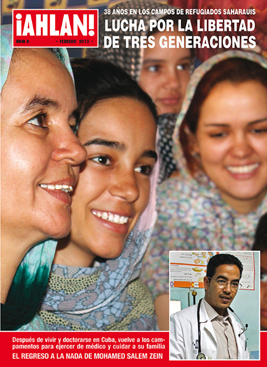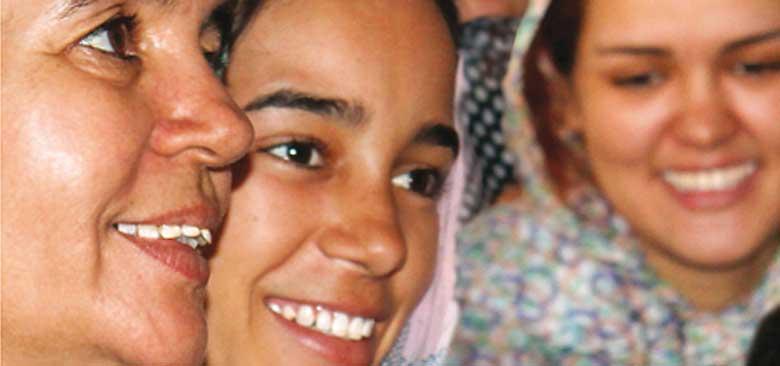At the end of 2013, ¡AHLAN!, Nuria Carrasco’s fake Hello! magazine project, was selected as one of the best photographic reports of the year by Martin Parr and the British Journal of Photography. Her work uses satire and irony to depict the reality of a situation largely ignored by the international community: life in the Saharan Tindouf camps. Nuria spoke to us about her artistic process and her views on how art can have a subtle influence on public opinion by ‘problematising’ and putting an image to situations and concepts that we find uncomfortable, or tend to forget.
At the end of 2013, ¡AHLAN!, Nuria Carrasco’s fake Hello! magazine project, was selected as one of the best photographic reports of the year by Martin Parr and the British Journal of Photography. Her work uses satire and irony to depict the reality of a situation largely ignored by the international community: life in the Saharan Tindouf camps. Nuria spoke to us about her artistic process and her views on how art can have a subtle influence on public opinion by ‘problematising’ and putting an image to situations and concepts that we find uncomfortable, or tend to forget.
They all correspond to a particular intention of mine: to create from a basis of satire and humour, using unexpected images.
You were one of the artists chosen by the public to attend the International Art and Human Rights meeting in Western Sahara, but where did the idea of presenting a fake Hello! magazine come from? It was almost an organic process: I had a bit of an idea after my last project, ‘Fortuna 82, Moraleja 13’, where I had used irony alongside an exchange of roles between people from different social classes. And then after talking to my friend Carmen Campos, I had the idea of using Hello! magazine as a basis for a piece of work, so when ARTifariti1 invited me to do a piece on the Western Sahara, I thought that it would be the perfect format to tell this story.

.
How does this project fit in with your earlier work? How would you define your artistic process? The truth is that all of my projects, even if I’m not always aware of it, have a common thread. The format varies with the scope of the proposal, but the aim of all of my works is to show certain social conflicts, in the context of the reality of daily life. And so when I look back, I can clearly see the linearity. Sometimes one project leads me on to another, as in the case of ¡AHLAN!. They all correspond to a particular intention of mine: to create from a basis of satire and humour, using unexpected images. I love my work, and I have fun with it; even if I’m dealing with ‘hard’ subjects, doing it through irony seems to me to be more effective than how the information is presented through the media, the way we’re used to it.
And going back to ¡AHLAN!, what was the hardest part of the project? The hardest part was when I arrived at the Saharan camps and had to face the reality of the situation. It’s one thing having an idea in your head when you propose a project, and another thing entirely when you arrive and have to confront it. In this case, I was very aware that the material that I would have to work with was very delicate, and I took great care to ensure that the people who would appear in the magazine were treated with the utmost respect. On the other hand, it was a marvellous experience, because I had the time to get to know them first, to live with them, to share some amazing moments, and everything came together very naturally, we all felt very comfortable with one another, it was wonderful.
And your fondest memory? I have lots, but perhaps the most moving was when we reached our crowdfunding target and had enough money to produce the magazine: it was really tough, but to see how many people were willing to get involved to make ¡AHLAN! a reality was incredible. I don’t have the words to describe how grateful I am.
A few days ago, your project was chosen as one of the best photographic reports of the year by Martin Parr and the British Journal of Photography. Do you believe that it is important for artistic works to tell the stories that are ignored by international organisations? Do you think that an artist can affect public opinion by ‘problematising’ situations that these organisations find uncomfortable, or that they have forgotten, by making them visible? Yes, I strongly believe in this kind of work. The fact that so many people have got in touch to request copies of the magazine, even those already interested in the Saharan conflict, just goes to show how important it is. I think that the circles that artists can move in can become platforms for making social conflicts visible, where we can present realities that are, yes, forgotten or not talked about, because making them known or presenting them from another point of view is very important.
It’s one thing having an idea in your head when you propose a project, and another thing entirely when you arrive and have to confront it. In this case, I was very aware that the material that I would have to work with was very delicate, and I took great care to ensure that the people who would appear in the magazine were treated with the utmost respect.
Do you think that platforms and meetings like Artifariti (*) are necessary? Completely, and I don’t know any other proposal that works like this one, facilitating the possibility for artists to go and create work from inside the reality of a conflict, living alongside it. For me this was fundamentally important for the whole process of my project to work.
Do you believe in the transformative power of art? I believe in the power of art to provoke thought and reflection about what it represents, but I don’t know if I’d call that transformative.
Do you know people who have become interested in the situation in the Western Sahara thanks to your project? No, I don’t personally know anyone who become interested in the Saharan conflict purely through ¡AHLAN!, but I do know people involved in activism around this issue that have been enthusiastic about the project, have supported it and have publicised it.
In your opinion, what should the role of the artist be in modern society? I don’t exactly agree that there is a specific ‘role of the artist’, but what I do believe is that as an artist, you have the creative potential to use your artistic work to make aspects of a situation visible, something that other disciplines can’t do. You can potentially create situations from which to investigate, can delve into aspects that other fields can’t access and then make use of certain public circuits in order to communicate and to exhibit that reality that you’ve been investigating.
I think that the circles that artists can move in can become platforms for making social conflicts visible, where we can present realities that are, yes, forgotten or not talked about, because making them known or presenting them from another point of view is very important.
For you, which other project stands out from Artifariti 2012? I thought that ‘Cous Cous Western’ by Left Hand Rotation and the performances by Los Torreznos were amazing: it was incredible to see how they turned the camp upside down, and to watch other forms of creation that are so completely different from painting and the plastic arts, and we all really enjoyed it.
What projects do you have in mind for the future? Well, as I was saying about one project leading to another… At the moment I’m working on another project in a magazine format, which will be presented at the Cartagena Biennial in Colombia, with the same philosophy as ¡AHLAN! but focused on a very different reality, that of Cartagena de Indias, with all of the complexity that entails. The magazine will be a spoof on “Caras”, the most popular ‘society’ magazine over there.
And to finish, how can we get involved with the ¡AHLAN! project? The fundamental aim of ¡AHLAN! is to spread the word about the project, because the more people that are aware of the Saharan conflict, the sooner we’ll move away from this apathetic ‘stand-by state’ of responsibilities, which we’ve been living in for the past 38 years. You can access the magazine through my website, and send the link to whatever part of the world you like:
http://www.nuriacarrasco.com/index.php?/projects/ahlan/
(*) Artifariti: A group which organises fortnight-long artist residencies in the Western Sahara, focusing on the depiction of human rights issues, cross-cultural collaboration and raising awareness of the political situation in the area.
[su_note note_color=”#eaeae9″]Translated by Alison Walsh[/su_note]

